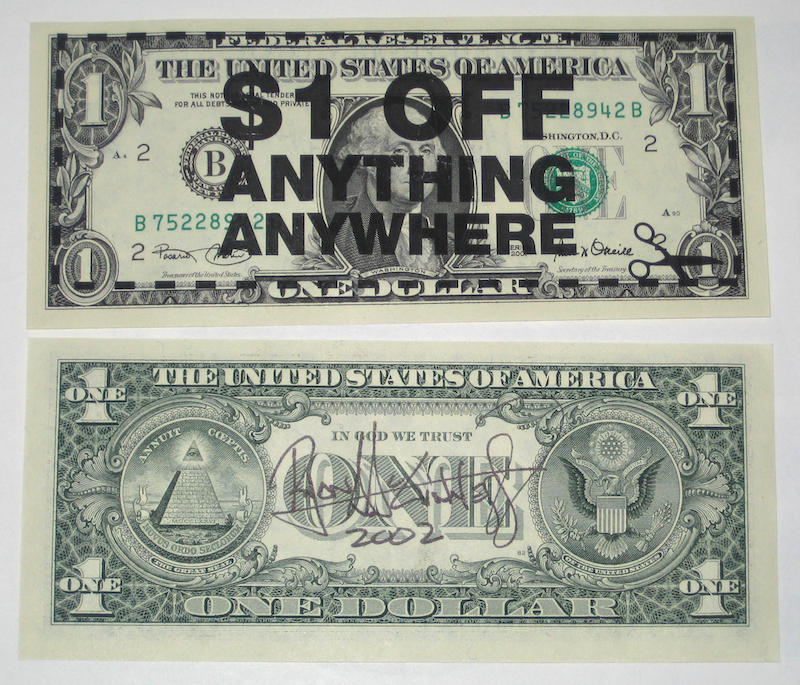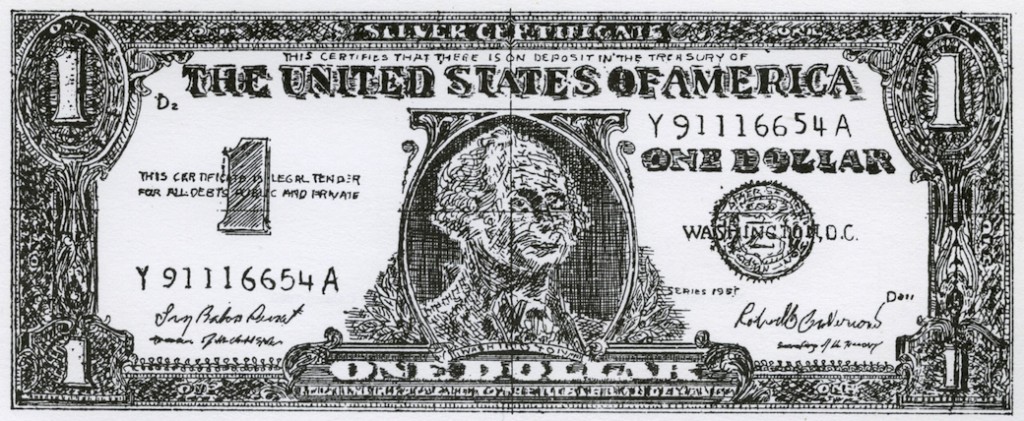
Ryan McGinness. $1 Off Anything Anywhere, 2002. Press type on $1 dollar bill; 2.6 x 6.1 inches. Courtesy Kirby Gookin.
Feelings about value have nothing to do with the structure of the things themselves…The marble of the Venus de Milo means something quite different to the crystallographer and to the art critic. —Georg Simmel, Philosophy of Money, 1900
Money has been created in many forms over the course of human history. People have used seashells, animal teeth, clay baubles, and metal discs as units of exchange and value. Perhaps the most spectacular monetary form—if only because it seems so antithetical to the form used in most contemporary societies—is the stone disc, or rai, which can be as large as twelve feet in diameter. This archaic form of money is still used for ceremonial exchanges by the people on the island of Yap in the Federated States of Micronesia. Unlike a coin or banknote that we carry in our pockets, a rai is rarely moved. Instead, its ownership is transferred between individuals based on verbal agreement.
Physical money is imbued with value just as a work of art is imbued with meaning. Value, like meaning, is imposed upon an object by extrinsic forces. This is most clearly evident with paper currency: a one-dollar bill and a fifty-dollar bill are materially the same, yet each represents a differing value.
For the sociologist Georg Simmel, both economic and aesthetic values exist outside the substantive “structure”—that is, the materiality—of the object. As such, economic value is never intrinsic to the object itself but is derived through the judgment of the “reciprocal relationship between objects” as determined by their placement on a scale relative to other objects.1 This is the result of the historical transformation of money: value is no longer found in an object’s material properties but in its symbolic function.
The same logic motivated the Soviet Politburo to embalm Lenin’s body and display it publicly in Red Square. By negating the natural decay of his physical form, they hoped to prevent the decay of his ideology—and by extension his then-fragile legacy, the Soviet state.
Cary Leibowitz/Candyass. Candyass Money (with receipt), 1994. Glazed ceramic; approx. 2 x 3 inches. Courtesy Kirby Gookin. Cary Leibowitz/Candyass has made multiples from generic, office supply room kitsch by personalizing or otherwise inflecting coffee mugs, pencils, pennants, and yard sticks with witty self-deprecating humor. Candyass Money is a broken ceramic fragment that turns lemons into lemonade by declaring it currency and, when sold in a commercial art context, enables the artist to sell his “loss” for a profit.
As suggested in Simmel’s epigraph above, the Venus de Milo can be either a chunk of stone or a work of art. Lenin’s body is a mass of organic matter or a sacred relic of revolutionary ideology. What determines the distinction? One answer is cultural relativism. This might partially explain the distinction, for example, between the international outrage following the Taliban’s destruction of the colossal Bamiyan Buddha and Mullah Mohammed Omar’s iconoclastic claim, “We are only breaking stones.”2 However, cultural relativism doesn’t adequately address the nature of value or its relation to the formation of meaning: its meaningfulness.
The symbolic function of money, as that of art, is not impartial, contrary to the view of neoclassical economists who compare it to a neutral veil or the oil of a well-run machine. Their argument is like the National Rifle Association slogan (“Guns don’t kill people; people kill people”). Yet such an argument doesn’t apply to money because value and meaning reflect a moral order and thus are never neutral.
Robert Watts. Dollar Bill, 1962. Offset; 6.25 x 2.5 inches. Courtesy Kirby Gookin. Watts transforms the mechanical image into a unique work, in effect making an “original copy.” His gesture ultimately debases his work’s material value to a few cents. Except that it remains a work of art, and so its economic value is determined by its aesthetic value, an amount certain to exceed that of a $1 dollar bill.
Like economic value, an artwork’s meaning (its aesthetic value) is derived through a critical judgment that employs comparisons to establish the work’s place within, for example, a stylistic tradition or an established canon. This is the axiomatic principle formulated in Ferdinand de Saussure’s Cours de Linguistique Generale (1915), which states that language’s significance is not in “the material substance of words” but in the system of “signs and their relations.”3 Working at the historical moment when collage and montage were burgeoning art forms, de Saussure posited that no linguistic element has significance alone but only in relation to other elements. Meaning is determined through the perception of differences, like the phonemes or the juxtaposition of words in a sentence.
Perhaps this is what the economist Johann Philipp von Bethmann meant, when he commented on a panel with Joseph Beuys, “What is Money?”: “Money is a product of the human creativity…It is a product of our civilization and our culture and it is even…a work of art.”4 Money, like art, signifies. The symbolic functions of both raise the value of money and the meaning of art beyond the materials they are inscribed on.
________
1. Georg Simmel, Philosophy of Money (London, Boston: Routledge & Kegan Paul, 1978), 101.
2. Andrew Lawler, “Ancient Buddhas, Modern Peril,” New York Times, December 22, 2012. https://www.nytimes.com/2012/12/23/opinion/sunday/chinese-led-copper-mining-threatens-afghan-buddhist-monasteries.html?_r=0
3. Ferdinand de Saussure, Course in General Linguistics (New York: McGraw-Hill, 1966), 18, 102.
4. Joseph Beuys: What is Money? (United Kingdom: Clairview Books, 2010), 18.
